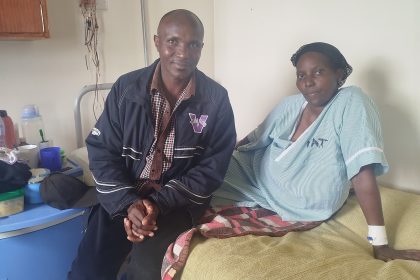Imagine your man taking a pill daily, with fewer side effects than hormonal options- and 99 per cent effective in preventing pregnancy…beyond condoms and vasectomies
For decades, the weight of contraception has largely rested on one set of shoulders: women’s. From daily pills to implants, IUDs (Intrauterine Devices), and injections, the vast majority of reversible birth control options have been designed for the female body. But shortly, the birth control pill for men could bring a monumental shift in reproductive responsibility beyond condoms and vasectomies.
For over 60 years, the oral contraceptive pill has given women unprecedented control over their reproductive lives. But this freedom came with side effects from hormonal birth control including: mood changes, anxiety, depression, and irritability, weight gain, migraines, nausea, changes in libido, blood clots, breast tenderness, acne and irregular bleeding.

These are daily realities that impact a woman’s quality of life. Consider Sarah, 32, a marketing executive in Nairobi, who recently switched her birth control method.
“I’ve been on the pill since I was 20,” she recounts. “It gave me control, yes, but the constant mood swings and bloating? It felt like my body wasn’t entirely my own. My partner, Alex, sees how it affects me, but what are his options?”
Alex’s options have historically been limited to condoms or a permanent vasectomy. This imbalance has meant that while men participate in sexual activity, the daily, ongoing responsibility and physical burden of preventing pregnancy has fallen almost entirely on women.
But the scientific community is making significant strides in developing new, reversible male contraceptive methods with promising developments:
1. The Non-Hormonal Pill (The Game Changer):
Imagine a pill a man takes daily, with far fewer side effects than hormonal options. Companies like YourChoice Therapeutics, in collaboration with Columbia University, have been developing YCT-529, a non-hormonal oral male contraceptive. But instead of targeting hormones, YCT-529 works by stopping the production of sperm by targeting a protein called RAR-alpha (think of it as the body’s “instruction manual” for making sperm) which is crucial in sperm production.
In studies with male mice and primates, it was shown to be 99 per cent effective in preventing pregnancy and fully reversible, with fertility returning quickly after stopping the drug, according to the researchers.
Crucially, a Phase 1 trial with 50 men in Australia showed no side effects, and a 90-day mid-stage study is planned to begin in the second quarter of 2025. This represents significant progress toward a male pill without the hormonal side effects like mood changes or weight gain commonly associated with female hormonal birth control.
This could mean Alex could take a pill that prevents pregnancy, giving Sarah a break from hormonal side effects.
2. The “Reversible Vasectomy” (Long-Acting Injectables):
Plan A (based on Vasalgel technology) and ADAM™ by Contraline are leading the charge in developing long-acting, reversible male contraceptives (LARCs), often dubbed “IUDs for men.”
Both Plan A (Vasalgel) and ADAM™ utilize a similar, ingenious mechanism: they create a physical barrier to sperm flow in the vas deferens (the two small tubes that carry sperm from the testicles like highways) to the urethra, where they mix with seminal fluid during ejaculation. In a traditional vasectomy, these tubes are cut and sealed, permanently preventing sperm from being part of the ejaculate.

Here, a doctor performs a minimally invasive procedure, typically under local anaesthesia, in an outpatient setting.
Similar to a no-scalpel vasectomy approach, a tiny opening is made in the scrotum to access the vas deferens. A hydrogel (a special gel that absorbs water and expands like a tiny sponge) is then injected directly into the vas deferens.
The injected gel forms a plug or a porous filter within the tube. This physically blocks sperm from passing through and mixing with the semen. Crucially, this process does not affect ejaculation volume or sensation. Men still ejaculate, but the fluid does not contain sperm- which is blocked by the gel and naturally reabsorbed by the body.
These contraceptives are designed to be long-acting, lasting for several years: The ADAM™ by Contraline shows remarkable effectiveness, with participants experiencing a 99.6-100 per cent reduction in motile sperm within 30 days of implantation, notes the researchers.
Current data shows it successfully blocks sperm for at least 24 months (two years) among participants in the ongoing Australian clinical trial expected to complete by 2025. Contraline hopes to start U.S. testing in 2025, with the goal for the product to be effective for one to two years.
Reversibility is the game-changing feature which differentiates it from traditional vasectomy
The Vasalgel (Plan A) on the other hand is meant to last for many years in humans, similar to how an IUD works for women, though it’s not yet in clinical trials. The reversibility is the game-changing feature and which differentiates the methods from a traditional vasectomy, which, while sometimes reversible, is often considered permanent.
The ADAM™ by Contraline has natural Biodegradation. This means the ADAM™’s hydrogel is engineered to break down and liquefy naturally in the body after a predetermined period, restoring sperm flow and fertility without requiring a separate removal procedure. This is a key design feature aimed at providing convenient reversibility.
Contraline is also developing protocols for an “on-demand reversal” procedure, should a man wish to restore fertility sooner than the natural biodegradation period. This would likely involve a minimally invasive procedure to flush out or remove the gel.
The Vasalgel (Plan A) also has an Injection-Based Reversal by a second injection of a simple solution (e.g., sodium bicarbonate, or baking soda solution) into the vas deferens. This solution flushes out or dissolves the gel, clearing the blockage and allowing sperm to flow again.
Kenyan men decide family size, while women bear physical burden of contraception
Kenya has made impressive progress in family planning—contraceptive use among married women rose from 32 per cent in 1998 to 61 per cent in 2020. Yet, 18 per cent still have unmet needs, according to the Kenya Health and Demographic Survey (KHDS 2022).
In many Kenyan communities, men often decide family size, while women bear the physical burden of contraception. Male contraceptives could fit cultural norms while sharing responsibility. Studies show that when Kenyan men engage in family planning, couples use contraception more consistently and see better results.

With over 9,000 health facilities and experience in distributing long-acting female contraceptives, Kenya is well-equipped to introduce male options when available.
Male birth control isn’t just about fairness; it could transform families and society:
- Empowering Women: It frees women from the sole responsibility of contraception, allowing them to choose methods purely for their own health and well-being, without the added pressure of preventing pregnancy.
- Fostering Partnership: It encourages shared decision-making within relationships about family planning. Instead of it being “her problem,” contraception becomes a joint endeavour, strengthening communication and trust. Research shows that when men are actively involved in family planning discussions, couples report greater satisfaction and better reproductive health outcomes.
- Reducing Unintended Pregnancies: More available and acceptable options for both sexes will inevitably lead to a reduction in unintended pregnancies, which have significant socio-economic impacts on families and communities globally.
- Promoting Gender Equality: It is a tangible step towards true gender equality in reproductive health, acknowledging that men have an equal role and responsibility in preventing pregnancy.
- Shifting Perspectives: It challenges the long-held cultural norm that contraception is primarily a female issue, fostering a more balanced and equitable approach to sexual health.
Consider John and Mary from rural Kenya. Mary has already had two challenging pregnancies and her doctor advises against a third for health reasons. John wants to support her but is hesitant about a permanent vasectomy.
The advent of a reversible male birth control option could offer them a solution that ensures Mary’s health while allowing John to take direct responsibility for their family planning without irreversible decisions.
The future of birth control is evolving from a unilateral burden to a shared journey, empowering both partners with choices-sooner than we think.
Dr Madeline Iseren is a Pharmacist and Creative non-fiction writer





















